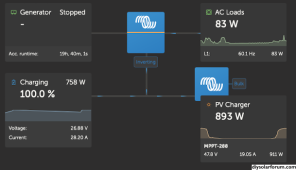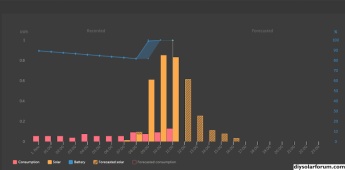Hi Folks. Hoping our battery gurus can shed some light on this situation. The system is comprised of six 210W panels (1260 watts max total, 3S2P) feeding a Victron MPPT 150/45. Inverter is a Victron 24V single phase (120V) 3000 KVA Multiplus. A Victron SmartShunt monitors charge/discharge and was calibrated at install, then again about a week ago, when the system was at 100% and stopped charging the batteries (i.e., it seemed to be "topped off". The batteries here are three 100AH Amperetime LiFePO4 24V batteries, in parallel (via a bus bar) with factory-crimped 1/0 cables (Battery Cables USA), all the same length, ~ 18" long. All connections are nice and tight and no cables become even slightly warm regardless of the load on the batteries. Two of these batteries were installed about a year ago, and a third added about six months ago. All appear fine, physically. All parameters are set according to the specs supplied by Amperetime for the batteries, with bulk charge being 28.4 V, Float 27V. Float is set to the Victron minimum of 0.25 hours. The Amperetime batteries apparently have a built-in BMS, but there is no way to interface with that (no app, etc.). There is no third party/external BMS.
The system has been working well, but there are a couple of things about which I'm curious, and that make me wonder if one of these batteries is "bad".
1) As shown below, the batteries continue to charge at a reasonably high current (usualy 26-30A, with 28.20 A showing in the pic below), and this continues for hours after the batteries show 100% SOC. They were full at 9:30 this morning, and they're still accepting much solar input at 12:23. Load has been fairly constant at 70-100W all morning. So, where is all that energy going, if the batteries were full at 9:30?
2) A few days ago, before I got my propane heater installed, i was using an oil-fired radiator to take the chill off the room, with about a 900W draw. Combined with the regular load, the system was supplying a fairly constant 1000W. The batteries were showing ~ 30% SOC, but Voltage was down below 22V early in the evening. When it hit the inverter low cutoff of 21.6V, the inverter shut down. I turned on the AC (generator) input and recharged, and all was fine. The next day I took the batteries down to about 33% but then removed the radiator load, and allowed the system to continue to discharge, but with a load of only about 30-50W plus the inverter draw of about 30W. When it got down to about 29% SOC overnight, the inverter again shut down because the batteries got down to 21.6 volts. But it got to that low voltage with under 100W of load total. Highly suspect, I think.
So, before I go disconnecting batteries and testing things, what's the group consensus? I suspect one of the three batteries is bad, but what do you think? Any advice on next steps? Thanks in advance.


The system has been working well, but there are a couple of things about which I'm curious, and that make me wonder if one of these batteries is "bad".
1) As shown below, the batteries continue to charge at a reasonably high current (usualy 26-30A, with 28.20 A showing in the pic below), and this continues for hours after the batteries show 100% SOC. They were full at 9:30 this morning, and they're still accepting much solar input at 12:23. Load has been fairly constant at 70-100W all morning. So, where is all that energy going, if the batteries were full at 9:30?
2) A few days ago, before I got my propane heater installed, i was using an oil-fired radiator to take the chill off the room, with about a 900W draw. Combined with the regular load, the system was supplying a fairly constant 1000W. The batteries were showing ~ 30% SOC, but Voltage was down below 22V early in the evening. When it hit the inverter low cutoff of 21.6V, the inverter shut down. I turned on the AC (generator) input and recharged, and all was fine. The next day I took the batteries down to about 33% but then removed the radiator load, and allowed the system to continue to discharge, but with a load of only about 30-50W plus the inverter draw of about 30W. When it got down to about 29% SOC overnight, the inverter again shut down because the batteries got down to 21.6 volts. But it got to that low voltage with under 100W of load total. Highly suspect, I think.
So, before I go disconnecting batteries and testing things, what's the group consensus? I suspect one of the three batteries is bad, but what do you think? Any advice on next steps? Thanks in advance.




